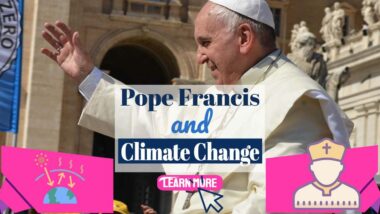The scary Climate Change story: Our house is engulfed in flames. Rapid climate change is causing global instability. It appears that our emissions will not be reduced in time to avoid rapid warming and that we will soon reach tipping points that will result in the disintegration of ecosystems and our civilization.
While scientists, activists, and many members of the younger generation are advocating for action, most politicians do not appear to be committed to taking meaningful action, and the fossil fuel industry continues to work against change.
People appear unable to overcome their greed and obsession with quick profits and personal gain in order to save themselves.
As a result, for many, the future appears bleak and hopeless. Young people are especially prone to anxiety and depression. Instead of thinking about the future and their options, they wonder if they will have a future at all, if they will be able to bring children into this world. This is a time of doom and hopelessness, and it appears that the only logical thing to do is to give up.
It's Wrong!
You are not destined to fail. The human race is not doomed. The situation is dire, but positive trends have built up over time, and there is finally good news and a clear path to our common climate goals.
Please watch our video all the way through. Check out our sources if you want to learn more. Good! Let's start with the most terrifying things.
1. Preventing the Apocalypse
Some of the most widely circulated myths about climate change are that it poses an existential threat, implying that the end of human civilization is imminent and that we may even vanish.
Also, at this point, it is unavoidable. But what does science have to say about it? By 2022, the global average temperature had risen by 1.2 degrees Celsius compared to pre-industrial times.
In comparison to pre-industrial times, the temperature has risen by 2 degrees Celsius.
The Paris Agreement's most ambitious goal was to limit global warming to 1.5 degrees Celsius. This goal's chances of being met are now slim. Hot spots will become hotter, humid areas will become wetter, and the risk of extreme weather events will rise as a result of today's warming.
 Warming above 2 degrees Celsius exacerbates everything; extreme weather events will become more frequent and severe, and more ecosystems will be under severe stress. Some will not make it. After the third degree, large parts of the Earth, particularly poor countries, may be unable to feed their people. Heatwaves will become a worldwide issue. Many natural systems will be thrown off-kilter.
Warming above 2 degrees Celsius exacerbates everything; extreme weather events will become more frequent and severe, and more ecosystems will be under severe stress. Some will not make it. After the third degree, large parts of the Earth, particularly poor countries, may be unable to feed their people. Heatwaves will become a worldwide issue. Many natural systems will be thrown off-kilter.
Hurricanes, fires, and droughts will become more powerful and frequent, causing billions of dollars in damage. The poorest areas and natural farmers will be the hardest hit. Hundreds of millions of people will be compelled to flee their homes. The apocalypse begins at 4 degrees. The earth is warming, and things are changing so quickly that it may be impossible to support such a large human population.
Billions could perish, leaving the rest to live on a scorched, deformed planet. Many scientists suggested a decade ago that this is our future due to a lack of action and perspective. A great deal of public communication was centred on this specific future path. Fortunately, today's apocalypse is much less likely to occur. If current climate policies do not change, warming will likely stop at 3 degrees Celsius by 2100, which is frightening, tragic, and unacceptable.
But it's not all bad news – how so? We have made so much progress in the last decade that most scientists now believe we have avoided a climate apocalypse.
Although there is still a significant risk, we can say with certainty that humanity is not going anywhere. Civilization will, at best, change, but it will endure. This begs the question, what has changed so drastically in the last decade that we can make such a claim?
2. The Invisible Transformation
You've probably heard the story: global climate policies have been a colossal failure over the last decade. Instead of enacting comprehensive, legally binding regulations that would significantly reduce emissions, we have largely remained inactive. A lost decade with a slew of bad records. This is one of the reasons why so many people give up.
But that isn't the entire picture.
Despite the lack of climate policies, the fossil fuel industries' relentless lobbying campaigns, and the spread of misinformation, we have made significant progress. Let's look back 20 years to see what's changed: Greenhouse gas emissions increased by 24% between 2000 and 2010, more than tripling the previous decade. Subsidies for fossil fuels, which promote economic growth, have resulted in a massive increase in consumption. Coal was the cheapest fuel for developing countries like China and India's growth, and rich countries showed no interest in changing their ways.
Many people predicted that these trends would continue in 2010. They said that rather than reducing our reliance on fossil fuels, we will increase it.
However, the following decade proved to be very different. First, coal growth in developing countries has slowed or stopped, as in India and China. And rich countries such as the United States and the United Kingdom are rapidly abandoning coal.
Three-quarters of planned coal plants have been cancelled since 2015, and 44 countries have pledged to stop building them. This seemed like a distant dream ten years ago.
Today, we can confidently state that coal has taken its last breath. They simply aren't competitive. Because technologies that we thought would be expensive in the long run became significantly less expensive.
Renewable energy has advanced at a breakneck pace. Wind energy has dropped three times in price in just a decade. Solar energy is now ten times less expensive! Despite massive subsidies and global infrastructure, they are less expensive than any fossil fuel power plant.
Today, 25 times more solar and nearly 5 times more wind energy is produced than ten years ago, but this is clearly insufficient.
One of the most significant challenges is their variability. Renewable energy sources, such as expensive batteries, must be stored in order to be reliable. Surprisingly, their cost has dropped by 97% in the last 30 years, and by 60%in the last decade, benefiting all types of green technologies such as electric vehicles. You may think it's fantastic, but didn't the most recent Kurzgesagt climate video state that, while wind and solar are fantastic, we need a radical shift in our global industrial system? Yes, but thankfully, change is not limited to the energy sector.
People all over the world are working to improve modern technologies in order to reduce emissions. We are rapidly replacing incandescent bulbs with LEDs, which are ten times more efficient.
In 2020, approximately 7 out of 10 new cars in Norway were electric or hybrid; by 2021, this figure has risen to 8 out of 10. The list goes on: electric heating, improved insulation, and slow-moving ships that save fuel. Everywhere you look, scientists, engineers, and business owners are attempting to address some aspect of climate change.
This problem requires a great deal of human ingenuity, and more and more people are prioritising climate change prevention. Low-emission cement, steel, electronics, and innovations such as artificial meat and CO2 capture are all being researched. The more we use these technologies, the less expensive and better they become. The more affordable they become, the more people will use them. And so forth.
Domestic CO2 production in rich countries is already declining in the absence of a major recession. Since 2000, the EU as a whole has decreased by 21%, Italy by 28%, the UK by 35%, and Denmark by 43%. The best news is that emissions are no longer inextricably linked to economic growth. In the past, this was an awkward truth.
You had to emit CO2 in order to become wealthy.
This has sparked heated debates between developing and developed countries about how fair it is to reduce emissions while their people remain impoverished. However, we have seen over the last decade that it is possible to increase wealth without increasing emissions. Emissions in the Czech Republic fell by 13%, while GDP increased by 27%! France reduced CO2 emissions by 14% while increasing GDP by 15%! Romania achieved an 8% decline and a 35% increase!
Even the world's largest economy, the United States, reduced emissions by 4% while increasing GDP by 26%! Some will argue that this is a statistical lie, that rich countries are simply exporting their emissions to poorer countries by shifting dirty parts of their economies, such as manufacturing, to poorer countries. Even when all imported goods are counted, the numbers do not change much! It is no longer necessary to choose between wealth and environmental protection, as it was a decade ago. Developing countries will benefit from this because rich countries fund the costly development of green technologies, while poor countries benefit from them.
The period of high emissions that today's rich countries have experienced may be overlooked. At this point, failing to reduce your emissions is a bad business decision. We haven't even touched on solutions like carbon capture. This did not exist in the year 2000. The technology is available in 2022.
A tonne of CO2 removed from the atmosphere costs $ 600. More investment will allow the technology to be consolidated and used on a larger scale, lowering the price in the coming decades. So, everything is fine? Let's not get too carried away. It's all good, but you need to pick up the pace.
There is still far too little being done. Technology will not solve all of our problems. To create durable and efficient goods that can be repaired, we need to use fewer resources and use them more wisely. We require significantly improved infrastructure, agriculture, and cities. It will be difficult, particularly to adopt and implement the appropriate policies.
However, for the first time, things are moving in the right direction. Imagine what humanity can do when climate change finally receives the political attention and funding it requires if all of this was accomplished without financial and political support, despite the lobbying of the fossil fuel industries.
So, is it a good thing to be hopeful again? What's the point of focusing on this side of the story when the situation is difficult and serious?
3. The hopelessness trap
Many people are concerned about climate change, which makes the future appear bleak. The sadness and hopelessness they feel are real and extremely damaging because it leads to apathy. Apathy only benefits the fossil fuel industry, which is still doing everything it can to slow down change. They have, in a sense, armed our hopelessness. We have reached the fourth stage of the public debate on climate change: Climate change is not real, according to Phase 1.
Climate change is real, but it is not caused by humans. Climate change may be man-made, but it isn't all that bad, according to Phase 3.
Climate change is unavoidable?
Climate change is unavoidable, according to Phase 4. We're doomed, and there's nothing we can do about it. We must first believe that change is possible if we want the world to change.
And there's plenty of evidence to back it up. Changes in our industrial system are gaining traction, technology is improving and becoming more affordable, and the environment is becoming an important topic in free elections. More and more young people are ascending to positions of power, prioritising the environment and developing new solutions. In 2022, most governments, both democracies and autocracies, not only recognise it, but also set their own goals. The victory is clear after years of fighting up a steep slope.
To keep the promises made today, the pressure must continue and increase. Doom means giving up, even though we can still avoid not only the worst-case scenario, but also most of the negative consequences, adapt in time, and save the poor from unnecessary suffering. That is why hopelessness and apathy are risky. If the last decade has taught us anything, it is that we are making progress and that the worst-case scenarios are only predictions, not foregone conclusions.
Based on current policies, there will be a 3°C warming beginning in 2022.
It is now our turn to prove these predictions wrong, no matter how serious or urgent they are. Let's reduce those three degrees to two and see where we can go from there. That necessitates hope. We hope to be able to give you some of it today. To recognise that things are serious, but that you have a future.
That it is possible to have children without endangering them or the world.
That it is worthwhile to act now. And that, despite the power industries' efforts to delay it, society is changing. If you require something more specific that you can do in person, we are currently working on a video in which we will discuss it in greater detail.
For forces that do not want change, the only trump cards left are doom, inaction, and armed hopelessness.
Don't give them the upper hand.
[Brilliant, an interactive educational website, sponsored this video.]
10 Ways to Reduce Climate Change as a Student
Ten Strategies for Students to Help to Slow Down Climate Change Hey there! Climate change is a hot topic, and rightly so. It's affecting our planet in ways we can't ignore. But as students, you might wonder how you can make a difference. Well, you're in luck! There are plenty of ways to help reduce […]
From Humble Beginnings to Industry Leaders: The Story of Landia UK's Growth with Liz Robinson
Discover the remarkable 30-year journey of Landia UK, a leader in pump manufacturing. Join Liz Robinson as she reflects on her pivotal role from the company's humble beginnings to its status as an industry innovator in the UK and Ireland. Learn how Landia UK's commitment to quality and customer service has driven its growth and […]
15 Ways to Prevent Climate Change
Here we describe 15 great Ways to Prevent Climate Change. There are a huge number of ways you can help prevent climate change, from making small changes to your daily routine to voting in elections that promote environmental change. Are you in a rush? Then just read this! Below are ten quick suggested actions that […]
Overfishing – Causes of Overfishing and Overfishing Solutions
The term overfishing is often assumed to refer to the overfishing of fish but in fact, it refers to all aquatic species including shellfish, crabs, lobsters and many others. In a recent study, the University of British Columbia found that China provides the most harmful subsidies to the industry. In fact, in 2011, they provided […]







